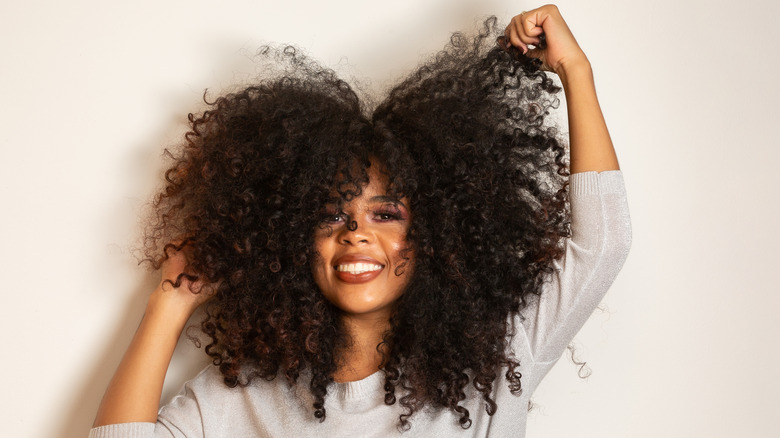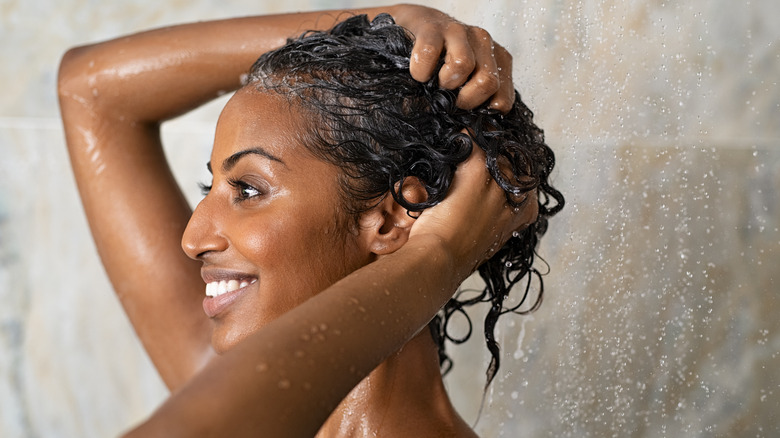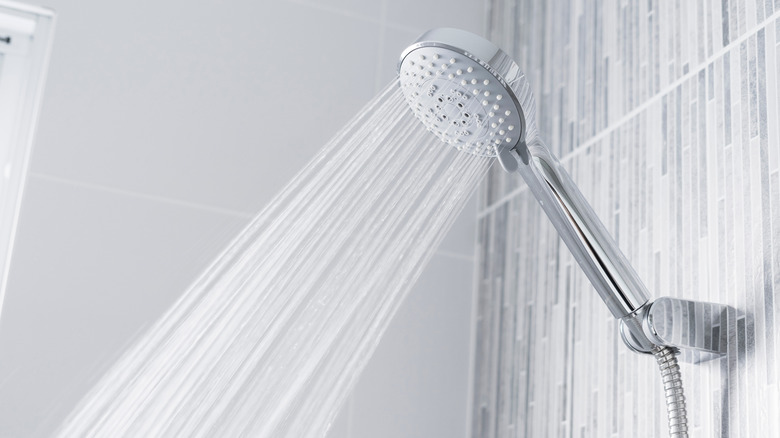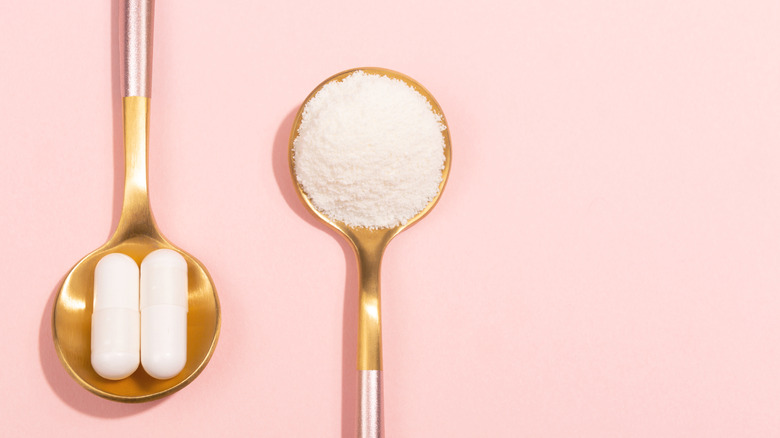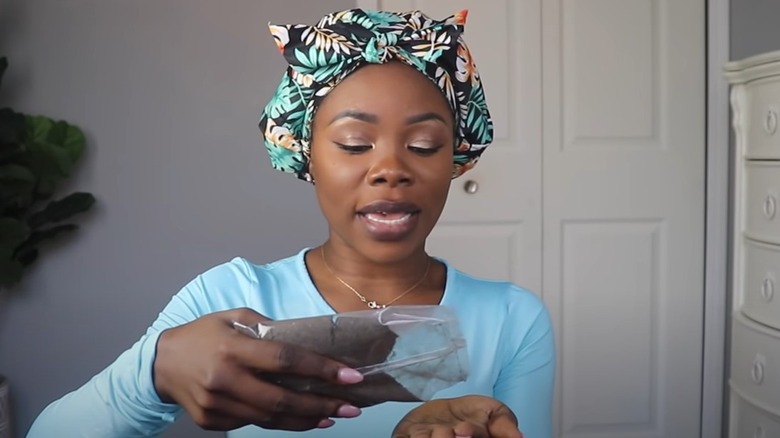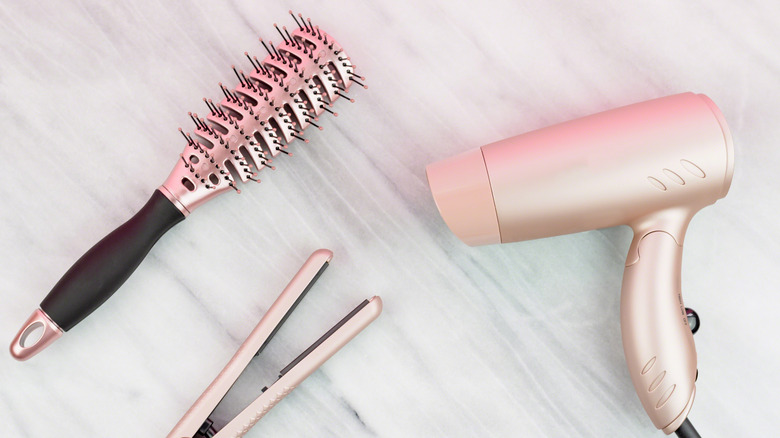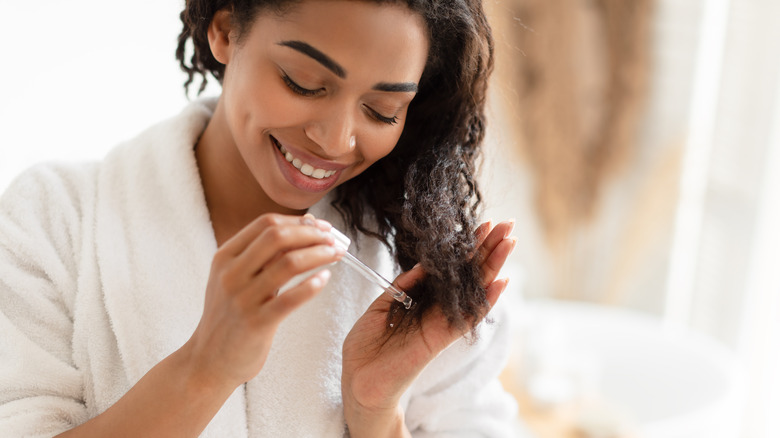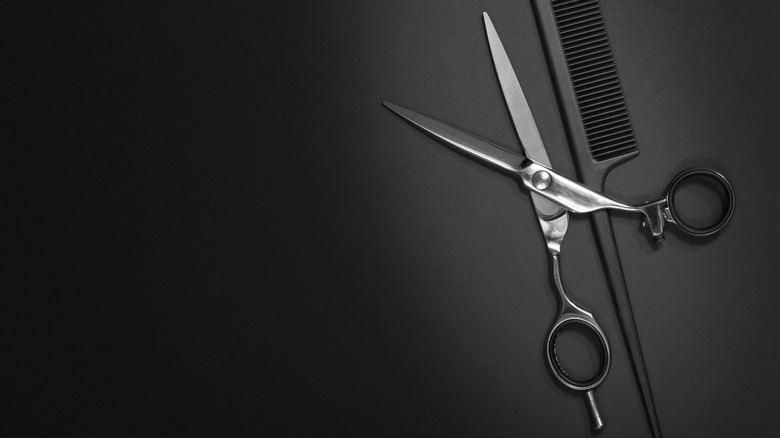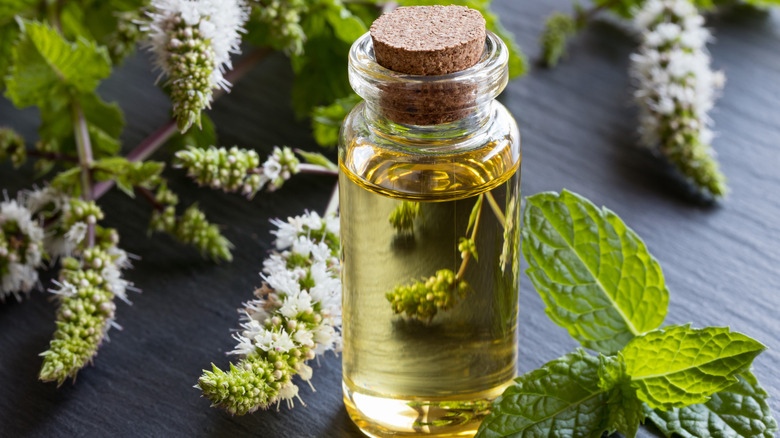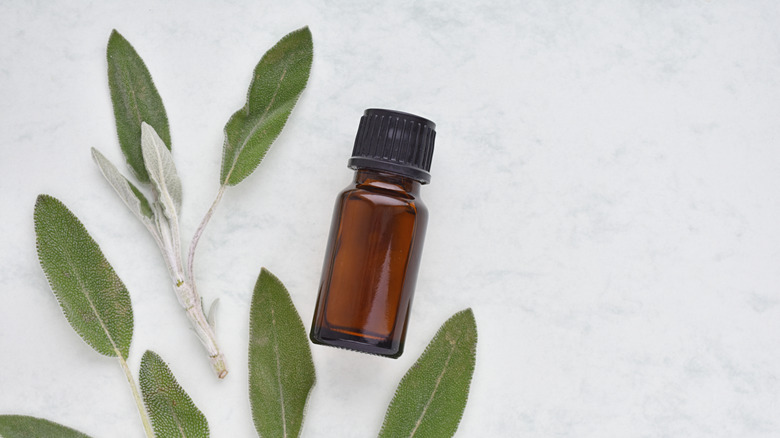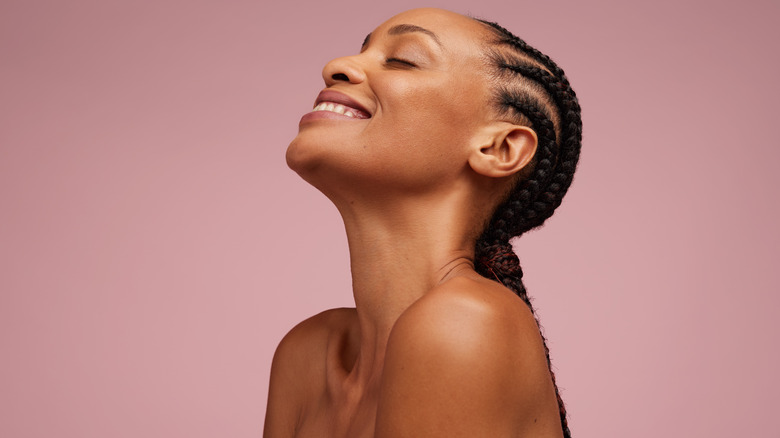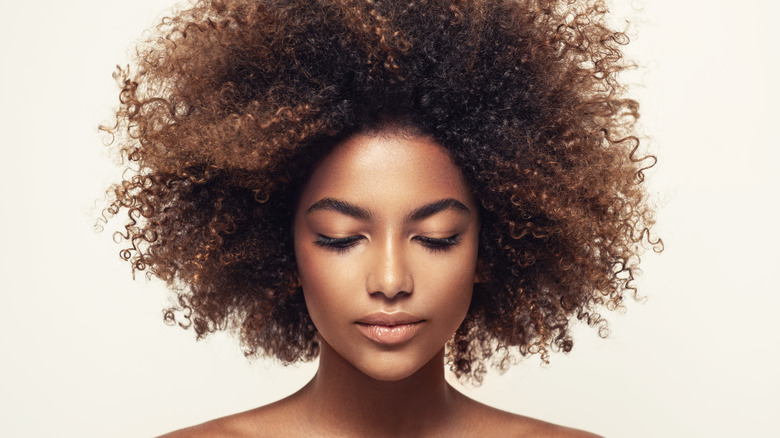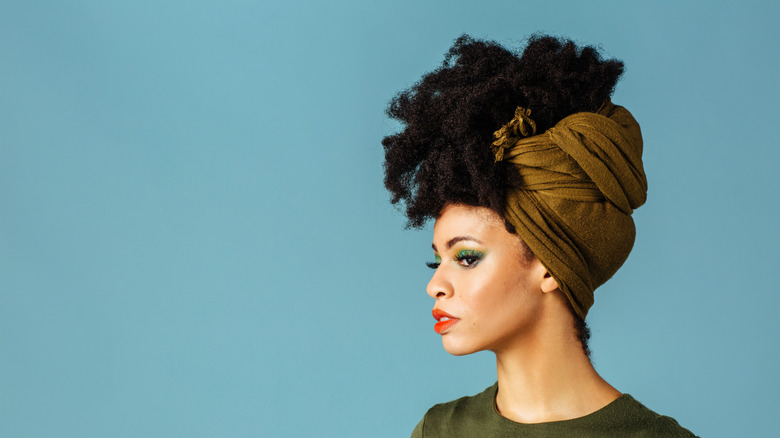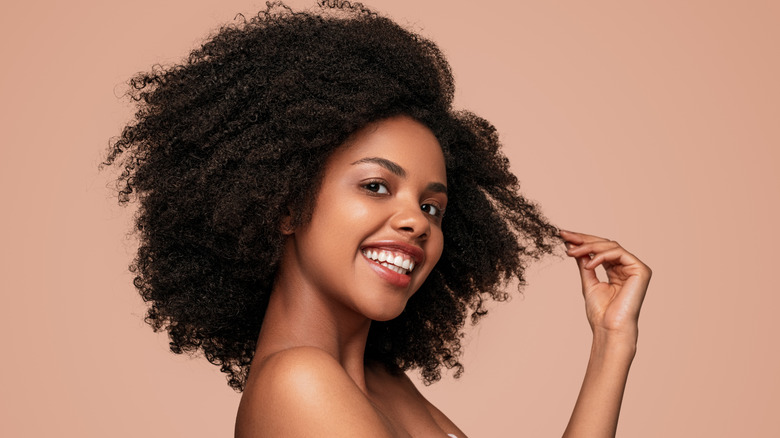How To Gain More Inches If You Have Natural Hair
Before getting super deep into this topic, something that must go on record is most people grow about a half-inch of hair a month. It doesn't matter what your ethnicity or hair texture is, this is a science-based fact (via Healthline). The reason why it may seem like some people's hair grows faster than others is oftentimes due to what their hair type is. Meaning, if their hair has a straighter texture to it, it will appear as if it is growing faster. Plus, there is something to be said for the fact that if the ends of your hair strands are breaking off just about as fast as the roots of your hair are growing, it could feel like you are making absolutely no hair growth progress.
Both of these issues tend to directly affect Black women who may choose to keep their hair in its natural state because, for most, their hair has tight curls or coils. If you are a Black woman and your goal this year is to gain some more inches as far as your tresses are concerned, here are some proven tips to help to make that happen.
Know your hair's texture and porosity
If you're someone who has tried a hair product that was recommended on YouTube or by a friend that seemed to work well for others but not for you, your hair texture and/or porosity may have had something to do with it. Your hair's texture is all about the width and thickness of your hair strands while your hair's porosity is about how your hair retains moisture (via Healthline).
Taking some time out to study these things is essential because that's how you can figure out what hair products will complement your locks the best. To determine your hair's porosity (which could be high, low, or normal), Carol's Daughter recommends taking a porosity test. "Simply spritz some water onto your hair when it's dry and take note of how fast your hair absorbs the moisture," L'Oréal explained. "If it soaks the water up right away, it's indicative of having highly porous hair. If the water sits on top of your strands for longer, then your hair likely has a low porosity."
Once you are clear on what your texture and porosity are, you can feel more confident about looking for things that will help to strengthen your hair which will reduce your chances of damage and breakage over time.
Deep condition your hair on every wash day
No matter what your hair's texture or porosity, you can be sure it's going to need moisture regularly. One way to ensure you're hair is moisturized is to deep condition it each and every wash day. "Deep conditioners will have a thicker, heavier concentration [than regular conditioners]," Dr.Deanne Mraz Robinson, assistant clinical professor of dermatology at Yale New Haven Hospital," told Healthline. "They may also continue working for days after use, as they are formulated to penetrate the strand more deeply than surface-smoothing daily conditioners."
Naturally Curly shares that deep conditioning helps to add moisture and restore your scalp's pH balance. Plus, it promotes elasticity and makes your hair so much more manageable for styling. The key to making this work in your favor is to allow a little extra time for your conditioner of choice to penetrate your hair's cuticles. That usually takes between 20 and 30 minutes (via Healthline).
If for whatever reason your hair needs a bit more moisture after taking this step, a leave-in conditioner can help. Natural hair site Curly Nikki features several popular leave-in brands that you can feel confident about.
Rinse your hair with cool water
When your head is under the showerhead or faucet, what's the temperature of the water like? While it might feel pretty amazing for it to be as hot as possible, that's actually not doing your hair much good.
According to Vogue, using hot water to shampoo and condition your hair can zap your tresses of the fatty lipids they need in order to avoid becoming dry and brittle. Celebrity hairstylist Florian Hurel told the publication, "Washing your hair with cold water helps with closing your cuticle after the wash. This also has the added benefit of helping, along with your hair care products, to make your hair look strong and shiny, and who doesn't want that?"
While it might take some getting used to, try at least rinsing your hair in cooler water. After a few wash days, you will likely notice a real difference.
Get routine protein treatments
Your hair is mostly made up of a protein called keratin, so it makes perfect sense that you would need to be intentional about making sure that you have a good balance of protein in your locks. Eating foods that are high in protein — salmon, chicken, eggs, lentils and peanut butter — is a good place to start (via EatingWell). Another approach is to give yourself a protein treatment. If your hair is overprocessed, breaks easily, or lacks elasticity, it's a good time for a treatment.
Protein treatments are awesome because they help to "fill in those gaps" along the strands of your hair — gaps that may have come from heat or chemically treating your hair. As a result of these treatments, your hair will be stronger and you'll notice a lot less frizz (via Byrdie). Naturally Curly recommends performing these treatments once every four to six weeks.
Experiment with chebe powder
Hair products trend like pretty much everything else. Chebe powder is one trend gaining more and more attention, especially within the Black hair community. African women in Chad have been using the powder — which is "made with cherry seeds, lavender, resin tree sap, cloves, and stones," according to hairstylist Annagjid "Kee" Taylor – for years in order to retain length (via Harper's Bazaar).
According to Naturally Curly, some of the perks of using this powder are restoring the balance of your scalp's pH and deep conditioning your hair. Chebe powder also boasts anti-inflammatory properties to protect your scalp. Mindbodygreen adds that chebe powder locks in moisture, reduces breakage, and helps keep your color looking great.
To get the best results, mix the powder with a carrier oil and apply to wet, clean hair. Then let it sit for as long as you possibly can. After rinsing it off, your hair will instantly feel super soft, making it so much easier to style.
Be careful with the heat
Many natural hair experts will tell you that if you want to keep your hair healthy, you need to apply an "absolutely no heat" policy. But that might be a bit extreme. While it is indeed true that heat tends to break down your hair's keratin bonds, there are things that you can do to reduce the chances of this happening or at least minimize the damage.
According to Byrdie, deep conditioning, applying a thermal heat protectant, and using quality styling tools (e.g., blow dryer and flat iron) on a low heat setting can all help to protect your hair from damage. Another option is to put your tresses through what is known as "heat training," which involves softening the outside cuticle of your hair with heat in a way that damages it as little as possible (via Byrdie).
All of this is good to know if you're someone who enjoys your natural curly texture but also wants to straighten your hair from time to time without excessive damage.
Make sure to seal your ends
Since your ends are the oldest parts of your hair, that means they need the most TLC. One way to give them the pampering they truly deserve is to "seal" them. If you're not familiar with this process, it's what happens when you apply some sort of oil or butter (like shea or mango butter) to your hair in order to lock in moisture.
Sealing is usually something that's done on wash days. And while there are no steadfast rules regarding how often you should do it, Nikki "CurlyNikki" Walton, founder of the website Curly Nikki, told Essence that "the purpose of sealing is to lock in the moisture from wash day." She continued, saying, "If you find that your hair stays moisturized throughout the week until it's time to re-wash, then all you need to worry about is protecting your hair at night."
If sealing your ends is something that you're interested in learning more about, there are plenty of YouTube videos that can walk you through the process, with Simply Julia Lauren's tutorial and Karen of Curl House's how-to video being just two examples.
Give your hair an occasional 'dusting'
It might seem weird that if you want to grow more hair, you should trim it on a consistent basis, but it is vital for encouraging growth. When it comes to how often you should trim your locks, the popular Black hair care site Natural Hair Rules recommends somewhere between every three to four months.
If you notice some rough ends (which can be a sign of damage), split ends, or fairy knots in between trims, you can opt for a "dusting." As Cosmopolitan explained, dusting is "a technique in which you remove only the split ends, strand by strand." Dusting may seem intimidating at first but as long as you go slowly and focus only on the strands that need immediate attention, you can maintain your style without a major "cut." Of course, if you don't feel comfortable dusting your own hair, you can seek out the help of a professional.
Massage your scalp with peppermint oil
When it comes to your overall health and well-being, you can never go wrong with having some peppermint essential oil in your possession. It can be used to treat headaches, soothe aching joints, speed up the healing process of colds, suppress coughs, and reduce stress, according to the National Center for Complementary and Integrative Health. Peppermint can even treat nausea and bring relief to itchy skin (via Healthline). But the benefits don't stop there.
If you use peppermint oil to massage your scalp, the menthol may work to stimulate blood flow to your scalp, a study in Toxicological Research found. This, in turn, will promote hair growth because the more blood that goes to your follicles, the more nutrients they will receive. Just make sure to mix peppermint oil with a carrier oil before massaging into your scalp, advises Healthline. The menthol can be a little too strong if you've got a sensitive scalp.
Use rosemary or clary sage oil for your ends
From root to tip, your hair will benefit from rosemary and clary sage oil. Rosemary oil is great for your hair because it contains antioxidant, anti-inflammatory, and antimicrobial properties.
Board-certified dermatologist Marnie Nussbaum told Elle, "The rosemary plant contains carnosic acid which is known to heal nerve damage, tissue damage, and improve cellular turnover; therefore, it encourages nerve growth and improves blood circulation." She continued, saying, "The reason blood circulation is so important to hair growth is that without a proper blood supply, the follicles do not get the nutrients they need to grow the hair and they can die off." Due to the consistency of the oil, rosemary oil can be used to smooth out any split ends as well as seal your ends (via Byrdie).
Clary sage is also a great choice for your ends because it contains a phytochemical called linalyl acetate, which helps to strengthen your hair so that your strands do not break off as easily or often (via Healthline).
Style your hair with your fingers instead of combing or brushing
There are definitely going to be times when you're going to need to use a comb or brush to style your hair. When that is the case, a detangling tool is always your best option (via New York Magazine. However, if you want your hair to receive as little manipulation as possible, try styling it with your fingers.
In the article "Why I Don't Comb My 4c Hair Anymore" featured on Naturally Curly's website, the author shared that constantly combing her hair hindered length retention. In fact, it ended up damaging her strands by weakening them
When you're not wearing a protective style, consider going with a hairstyle like a "wash and go" (via Naturally Curly). It complements your natural hair texture, it will keep your hair full of moisture, and you won't have to do any real combing or brushing.
Keep it in a protective style (relatively) often
Hair is something that is both strong and fragile at the same time. That's why the less manipulation that it has to endure, the better. One way to keep your hands and styling tools out of it for relatively long periods of time is to put it into a protective style. Another perk that comes from opting for this style is that your ends will be tucked away from the elements, fabric of your clothing, and anything else that may cause more wear and tear. There are many protective styles to choose from, including box braids, Bantu knots, and faux locs (via L'Oréal).
While wearing a protective style, be sure to cleanse your scalp, moisturize your hair, and ultimately opt with a look that requires as little upkeep as possible (via Self). Ideally, you should leave your protective style in for six to eight weeks at a time (via Naturally Curly).
Always account for shrinkage
With curlier-textured hair, it can sometimes feel as if your hair just isn't growing. A lot of this has to do with what is called "shrinkage." This is especially true if you have 4-type hair, which is really tight coils (via Carol's Daughter).
Hair in its natural state is always beautiful, no matter what texture it may be. But if you're someone who wears your hair natural most of the time and you're feeling discouraged because it feels like no growth is happening, stretching out your strands could help.
According to Naturally Curly, you can reduce shrinkage by using silicone and beeswax products. Or, you can create a bentonite clay and apple cider vinegar mix to elongate your natural curls or to put your hair up into a pineapple (pile it up on the top of your head and tie the sides up with a scarf). Additionally, you can stretch out your hair without applying heat by using banding or threading methods.
Yes, sometimes shrinkage can be frustrating, but as long as you remember that curls can always be stretched out, it will remind you that your hair is actually longer than you think it is — and isn't that good to know?
Wrap your hair up at night
Most of us, on average, spend somewhere around six hours and 42 minutes in bed, according to The Atlantic. That's a lot of time for your hair to spend on a pillow. What this also means is your tresses are vulnerable to static and friction that can come from rolling around all night. However, a nighttime hair routine — one that consists of tying your hair up with a satin scarf or bonnet and also lying down on a satin pillowcase — can help (via Curly Nikki). "Even if you wear a bonnet/headscarf quite often they come off at night so having the satin pillowcase is extra protection," Curly Nikki explained.
Tying your hair up at night will help your hair retain moisture and your hairstyle will remain intact. It will also prevent you from having to deal with a lot of detangling the following morning. If done consistently, this simple bedtime step can make a really big difference.
Be patient with the process
Even if your hair happens to grow the standard amount of a half-inch every month and you're able to protect your ends from breakage, it would still take you an entire year to end up with six inches of new growth. So even with all of the tips in the world, something that you still need to apply in order to see real hair length results is patience — and a lot of it.
According to Healthline, you may be able to help the growth process along, at least a little bit, by taking multivitamins and getting more protein into your system. Using hair products that contain caffeine may also help accelerate growth. And luckily, there are many natural hair experts out in cyberspace who regularly offer tips. Popular YouTube channels like Naptural85 and Temi Adesina provide suggestions and hacks that can get you the inches you're looking for while also making it fun to play with your hair while you wait. Good luck on your hair growth journey!
